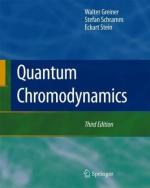|
This section contains 483 words (approx. 2 pages at 300 words per page) |

|
The theory of quantum electrodynamics (QED) has proved to be enormously successful in explaining interactions involving both electromagnetic and weak forces. So it is hardly surprising that physicists have considered the possibility of a similar theory that will explain interactions involving the strong force. That theory is now called quantum chromodynamics (QCD). The theory was developed in the early 1970s, partly as the result of research by Murray Gell-Mann on the basic structure of matter.
The fundamental components of quantum chromodynamics are quarks and gluons. Quarks are thought to be one of the two fundamental kinds of particles ( leptons are the other) of which all matter is made. Gluons are mediating particles that transmit the strong force between quarks and between themselves.
One of the fundamental problems leading to the development of QCD was finding particles containing identical quarks. The D+++ particle, for example, consists of...
|
This section contains 483 words (approx. 2 pages at 300 words per page) |

|


